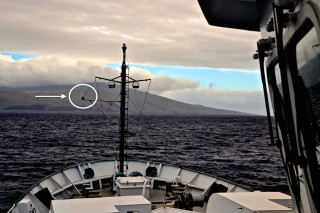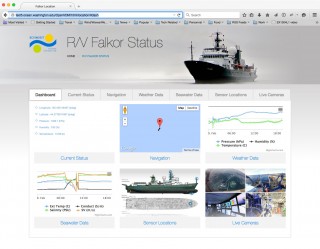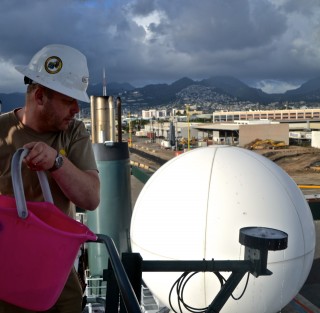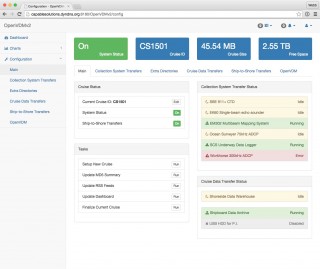
A recent blog explained new efforts at Schmidt Ocean Institute to make the data collected aboard R/V Falkor as easily and openly accessible as possible.
One of those efforts was the development of a new “data dashboard” Falkor status page, which went live this week. This is a step forward for Schmidt Ocean Institute in achieving one of the core components of its mission—catalyzing the sharing of information—but it is also part of a software development vision supported by SOI that could aid numerous other research vessels.

The dashboard currently offers data feeds from meteorological and seawater sensors, and the navigation system, as well as screen grabs from ship cameras. There’s also a tab that explains the locations on Falkor of many of the relevant sensors and instruments, and each section includes an explanation of the data displayed and how they are measured or collected.
The data that can be viewed on these webpages are automatically packaged aboard Falkor and sent to shore every 15 minutes via an open source software project called OpenVDM. Webb Pinner, founder of Capable Solutions was inspired to create the project based on his experiences working for over a decade as a “data rat” marine technician aboard various U.S. research vessels. Previously no such compilation software was available, meaning ship operators had to develop their own, often labor intensive, ways to package and catalogue their data.

Other ships are using OpenVDM to organize their data and make it more manageable for archiving, but Falkor is the first ship using OpenVDM to make data available for public viewing in near real-time, as the new status page makes possible. A primary goal for such increased accessibility is to make it easier for scientists and the public to grasp the value of oceanographic data, and to make new discoveries possible.
Moving Forward
Previously, OpenVDM had been mostly a labor of love, but Pinner had bigger ideas for what might be accomplished. Now, Schmidt Ocean Institute is providing support to Capable Solutions that will make such further development possible. “This venture was a big leap forward for OpenVDM,” says Pinner, “Schmidt Ocean Institute was the first organization to openly support the development of this technology for the sake of technology development, knowing that such work would benefit all the users.”

With this support, Pinner is already working on a new version of OpenVDM that will be an almost complete rewrite. The new version addresses feedback provided by all current OpenVDM users, including Schmidt Ocean Institute marine technicians. It will be more robust, will have a more intuitive interface and improved functionality, and should further streamline the task of managing oceanographic datasets at the vessel level.
Pinner is also exploring ways OpenVDM integrates additional data quality assessment algorithms to help marine technicians identify and resolve problems with sensors and equipment quickly while still at sea—instead of post-cruise when it’s too late. The Falkor status page will be improving as well, says Pinner, “We’ll be fine tuning and expanding functionality for months to come.”

